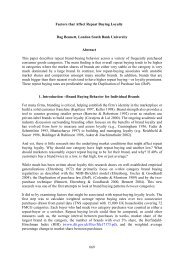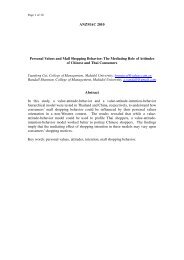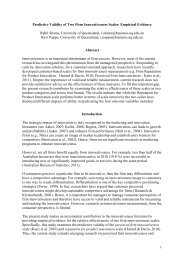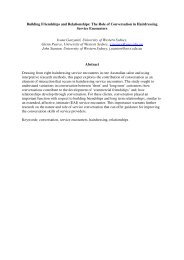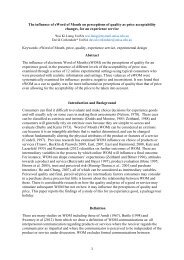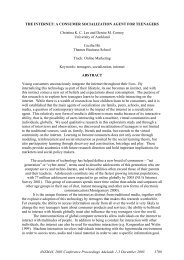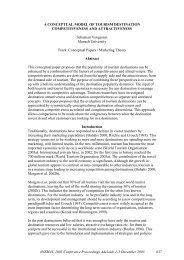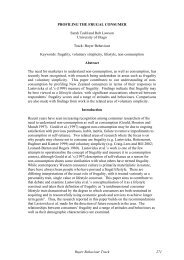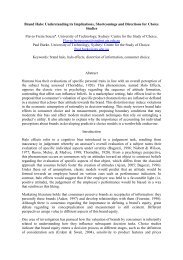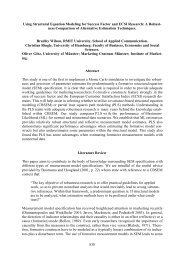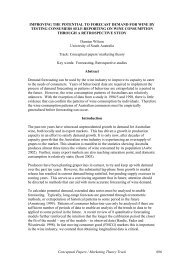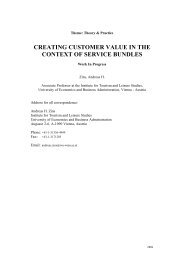amj Australasian Marketing Journal - ANZMAC
amj Australasian Marketing Journal - ANZMAC
amj Australasian Marketing Journal - ANZMAC
Create successful ePaper yourself
Turn your PDF publications into a flip-book with our unique Google optimized e-Paper software.
ularly in a text that gave so much attention to measures.<br />
A number of other omissions troubled me. The brand, product<br />
and customer perspectives needed to be betteranalysed. For<br />
example, brand loyalty was adequately treated but customer<br />
loyalty was not explained except for the Dick and Basu<br />
(1994) model in the slides (under brand loyalty). This omission<br />
reflected the lack of detailed consideration of issues<br />
stemming from the relationship marketing perspective.<br />
Customer retention is much talked about in industry, usually<br />
with a genuflection toward Reichheld (1996), and this<br />
suggests to me that the matter needs more comment in a text<br />
of this sort. Another omission was planned behaviour theory<br />
(Ajzen 1991). The text dealt with its predecessor (reasoned<br />
action) and the more esoteric theory of trying; it should have<br />
focused on the widely used and up-to-date theory of planned<br />
behaviour and given examples of its application. And what<br />
about the mathematical approaches? Despite the extensive<br />
treatment of diffusion there was no mention of the Bass<br />
model; similarly the Dirichlet was not discussed in the text<br />
though it appeared briefly in a case where the purchase incidence<br />
and brand choice of Japanese consumers is discussed.<br />
Supporting material<br />
The PowerPoint slides (prepared by Jennifer Thornton) were<br />
admirably clear and mostly avoided the distracting clip art<br />
and transition effects that are often used to excess in this<br />
medium. Some of the slides were a bit busy but there was<br />
nothing to stop a lecturer from adapting them. In general, they<br />
summarised the corresponding chapter and sometimes introduced<br />
a slightly different slant when compared with the book.<br />
However, there was little animation, no hyperlinking to the<br />
Internet or jumping to software, and no use of sound or video.<br />
I think that the more exotic features of PowerPoint are now<br />
more widely used and there is a real opportunity to introduce<br />
TV advertising, interviews and other dynamic material into<br />
PowerPoint. Traditional publishers need to give more thought<br />
to this since these additions will aid learning and sell texts.<br />
And academics with particular expertise need to provide<br />
video clips that can be used. I found the instructor s manual<br />
less useful than the PowerPoint slides. Much of the manual<br />
seemed to summarise the corresponding chapter and there<br />
was no need for this. Most lecturers find that undergraduates<br />
are reluctant to talk and ideas for practical activities are a<br />
boon; these were provided in the textbook and the additional<br />
suggestions in the instructor s manual added little.<br />
Overall assessment<br />
This book meets the requirements of lecturers who share the<br />
partly implicit assumptions of the authors that the subject is a<br />
continuation of marketing into social science and that a textbook<br />
should lay out related ideas, mainly from psychology<br />
and sociology, in a clear, descriptive and relatively uncritical<br />
manner. This is the widely accepted formula for consumer<br />
behaviour, which has evolved from foundation courses in<br />
Book Reviews<br />
pure psychology and social science. This treatment works<br />
quite well for sociological work but rather less well for<br />
psychology, which needs to be given a more hypotheticodeductive,<br />
theory-driven introduction. However, I do not<br />
think that this widely accepted view of consumer behaviour is<br />
sufficiently critical or demanding when the subject is taught<br />
as an end-of-course elective; then, I believe that there is merit<br />
in an alternative approach that starts with the marketing problem<br />
and makes more direct use of academic research in<br />
marketing.<br />
An alternative approach<br />
<strong>Marketing</strong> is a prescriptive discipline, like medicine or education.<br />
It must have a praxis, a body of do s and don ts covering<br />
positioning, segmentation, promotional spending etc and textbooks<br />
in marketing must meet this requirement. But, like<br />
medicine or education, there is a concurrent requirement to<br />
research the applications and integrate any findings into the<br />
curriculum. <strong>Marketing</strong> researchers do this but their work<br />
seems to be poorly used in undergraduate and MBA teaching.<br />
I see consumer behaviour as an evidence-based subject that<br />
uses this research and explains how consumers respond to<br />
marketing interventions. We should start with problems in<br />
marketing and follow these through, drawing on any social<br />
science or mathematical methods that help with the solution.<br />
Most textbooks in consumer behaviour do not do this. The<br />
way they cite papers illustrates their approach. A quick check<br />
of post-1997 texts shows that, with the honourable exception<br />
of Kardes (1998), consumer behaviour textbooks use the<br />
convention of removing references from the body of the text<br />
and putting them in a Notes section at the end of the chapter<br />
or book. This ensures that they are mostly not read and cannot<br />
be integrated into the argument. This practice may work for<br />
company reports but I have never seen any justification for it<br />
in textbooks. Removal of references from the text is a device<br />
for dumbing down. Unless the study is cited properly, it is<br />
difficult to discuss it in any detail and relate it to other studies.<br />
As a result, conclusions are stated and the alternative<br />
possibilities that attend any research or practice, which<br />
provide the basis for progress, are omitted. It is true that the<br />
books that use the references in text approach are harder but,<br />
if we take bright students into business courses, we have an<br />
obligation to make intellectual demands on them. The<br />
demands that we make should be commensurate with those<br />
that are made in other subjects such as economics and<br />
psychology.<br />
A second advantage of this approach is that much of the<br />
curriculum that is found in the standard textbooks can be<br />
dropped or can be taught in the first year as a social science<br />
course. Marketers do not use Maslow or Hertzberg, and they<br />
do not apply the extended box models that supposedly explain<br />
consumer choice. Personality analyses are of little relevance<br />
to practitioners. Similarly, Dichter and his psychoanalytic<br />
interpretation of consumer behaviour can be abandoned.<br />
<strong>Australasian</strong> <strong>Marketing</strong> <strong>Journal</strong> 9 (1), 2001 79



